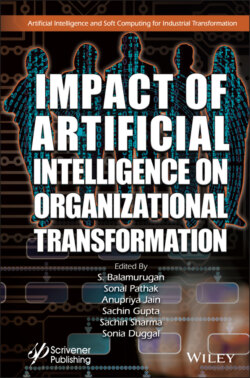Читать книгу Impact of Artificial Intelligence on Organizational Transformation - Группа авторов - Страница 14
1.1 Introduction
ОглавлениеArtificial Intelligence (AI) that was coined by McCarthy [3] is a branch of computer science encompassing areas such as machine learning (ML) and cognitive computing. AI can also be divided into the categories as strong AI, weak AI, and super intelligent AI. The strong AI or Artificial General Intelligence (AGI) refers to a system with logic, sensory and cognitive abilities that rely on the association of data to produce human brain-like decisions. The weak AI or Artificial Narrow Intelligence (ANI) is the system that focuses on a single task and work in a particular domain [34]. Super intelligent AI is a futuristic system that shall surpass the cognitive abilities and intelligence of human beings.
The study by Carbonell et al. has mentioned that ML is a basic requirement for the generation and development of AI [8]. The prominent ML tools are as follows:
1 a) Neural Network or Artificial Neural Network (ANN): It comprises of many interconnected nodes (like neurons in the brain) and works on the rules that define what kind of output to be generated based on input.
2 b) Support Vector Machine (SVM): It is used for predicting time series predictions.
3 c) Natural Language Processing (NLP): It consists of a) Natural Language Understanding (NLU) and b) Natural Language Generation (NLG). NLU converts the natural language into computer language; therefore, it is termed as Speech Recognition or speech to text conversion. It uses Hidden Markov Model (HMM).
According to Merriam Webster.com, “Artificial Intelligence is a branch of computer science dealing with the simulation of intelligent behavior in computers.”
According to John McCarthy, AI is “the science and engineering of making intelligent machines, especially intelligent computer programs” [22]. AI simulates intelligent behavior in computers. In ML, the machine learns on its own based on patterns and training data sets. It enables machines to process like the human brain.
It is revolutionizing various industries. The study conducted by Xaxis [35] concluded that AI will be the next industrial revolution. The economic impact of AI is estimated to reach 13 trillion dollars by 2030 [7].
A survey conducted by Deloitte on 250 executives on the benefits endowed by AI revealed that 51% of the executives were of the view that AI enhances the features, functions, and performance of the product, 36% of the employees were of the view that AI optimizes internal business operations, 36% of employees indicated that AI frees up the workforce to be more creative by automating tasks, 35% indicated that AI assists in making better decisions, 32% of the employees revealed that AI helps in creating new products, 30% of employees suggested that AI helps in optimizing external processes like marketing and sales, 25% of employees were of the view that AI helps in pursuing new markets, 25% revealed that AI helps in capturing and applying scarce knowledge where needed, whereas only 22% of employees indicated that AI reduced headcount through automation [9]. Figure 1.1 depicts the benefits endowed by AI on organizations. Thus, it can be seen that no aspect of management has been left untouched by AI. AI is gaining prominence in various managerial functions like HR, finance, and marketing. AI brings with it personalized experience.
A study carried by Oracle and human resources advisory and research firm, Future Workplace revealed that 80% of Asia Pacific (APAC) countries surveyed indicated that 50% of their employees are currently availing AI in some or the other form in their organization. The results also indicate that 77% of employees in China and 78% of employees in India have adopted AI which is more than double the 32% in France and 38% in the United Kingdom [23].
Figure 1.1 Benefits of Artificial Intelligence. Source: Deloitte 2017.
